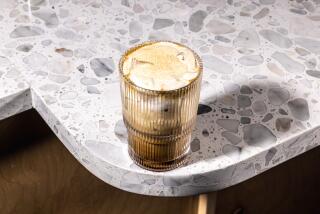Important dates in modern coffee connoisseurship
- Share via
1940s
American coffee roasters start blending cheap Robusta beans, high in caffeine but low in flavor, with their traditional Arabica coffee. The vast majority of Americans are brewing canned ground coffee in percolators.1947
Giovanni Achille Gaggia patents the modern espresso machine.Early 1950s
Gaggia’s machines start showing up in Greenwich Village Italian cafes. New York bohemians take up espresso.1956
Ambrose Pasquini opens Moka d’Oro, L.A.’s first cafe using a Gaggia espresso machine, at 1712 N. Vermont Ave. Robinson’s department store advertises a more primitive home espresso maker, the Nova Caffe.1957
Coffee House Positano opens in Malibu, initiating Southern California’s beatnik coffee house era. Thirty more espresso joints open in the following year.1961
Peak use of Robusta beans by coffee companies, followed by a 25-year decline in American coffee consumption.1962
The 1962 International Trade Agreement is signed, the first of a series of five-year agreements that cartelize coffee production. They stifle the market for specialty coffees until the agreement breaks down in 1989.1965
In “The Ipcress File,” Michael Caine’s hip spy character Harry Palmer uses a Chemex filter coffee maker, reflecting the growing dissatisfaction with ordinary coffee.1966
Peet’s Coffee, Tea and Spices opens in Berkeley selling specialty coffees; popularizes a relatively dark roast. In New York, Zabar’s revives interest in specialty coffees; uses a light roast.1973
Introduction of Mr. Coffee drip coffee maker, which helps wean Americans away from the percolator.1975
Hills Bros. introduces European Style Coffees flavored with cocoa, cinnamon and coconut, spawning the flavored coffee trend.1987
Starbucks, a Seattle coffee merchant which had recently acquired Peet’s, becomes a chain of coffee houses.Late 1980s
Caffe latte becomes popular; in a Far Side cartoon, one cowboy offers another a mug, saying, “Latte, Jed?” Proportion of latte to caffe rises year by year.1995
Starbucks promotes the Frappuccino, a slushy drink of coffee, milk and ice. The ice-blended era begins; coffee shops more and more resemble 1940s soda fountains.Late 1990s
A sizable wave of serious local coffee roasters.2005
Fifteen percent of adult Americans have a cup of specialty coffee every day.— Charles Perry
More to Read
Eat your way across L.A.
Get our weekly Tasting Notes newsletter for reviews, news and more.
You may occasionally receive promotional content from the Los Angeles Times.










